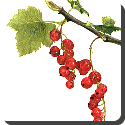 Currant — The currant is a hardy shrub in the genus Ribes, of the family Saxifraga. The genus includes about 150 species, of which the European black currant and the red currant are most important in cultivation. The European black currant is an alternate host for white pine blister rust, and planting is prohibited in many states to protect white pine forests. Consequently, currants are little cultivated in North America. Most of the world production is in Europe, with Great Britain, Poland, and West Germany being the leading producers. Most of the production is processed into juice, which in Europe is popular for its pleasant flavor and high vitamin content.
Currant — The currant is a hardy shrub in the genus Ribes, of the family Saxifraga. The genus includes about 150 species, of which the European black currant and the red currant are most important in cultivation. The European black currant is an alternate host for white pine blister rust, and planting is prohibited in many states to protect white pine forests. Consequently, currants are little cultivated in North America. Most of the world production is in Europe, with Great Britain, Poland, and West Germany being the leading producers. Most of the production is processed into juice, which in Europe is popular for its pleasant flavor and high vitamin content.
Ribes is a genus of about 150 species of flowering plants, usually treated as the only genus in the family Grossulariaceae. The genus is native throughout the temperate regions of the Northern Hemisphere.
Ribes includes the currants, including the edible currants (blackcurrant, redcurrant and whitecurrant), gooseberries, and many ornamental plants. The Ribes currant should not be confused with the Zante currant grape.
Currants are used as food plants by the larvae of some Lepidoptera species; see list of Lepidoptera that feed on currants.
Seven subgenera are recognised. A few taxonomists place the gooseberry species in a separate genus, Grossularia, despite the Jostaberry gooseberry/blackcurrant hybrid.
There are restrictions on growing Ribes species in many US states as they are a host for White Pine Blister Rust.
The Blackcurrant (Ribes nigrum) is a species of Ribes berry native to central and northern Europe and northern Asia. In French it is called a “cassis”.
It is a small shrub growing to 1–2 m tall. The leaves are alternate, simple,3-5 cm long and broad, and palmately lobed with five lobes, with a serrated margin. The flowers are 4–6 mm diameter, with five reddish-green to brownish petals; they are produced in racemes 5–10 cm long. The fruit is an edible berry 1 cm diameter, very dark purple in colour, almost black, with a glossy skin and a persistent calyx at the apex, and containing several seeds.
Plants from Asia are sometimes distinguished as a separate variety Ribes nigrum var. sibiricum, or even as a distinct species Ribes cyathiforme.
 Kids Portal For Parents India Kids Network
Kids Portal For Parents India Kids Network






